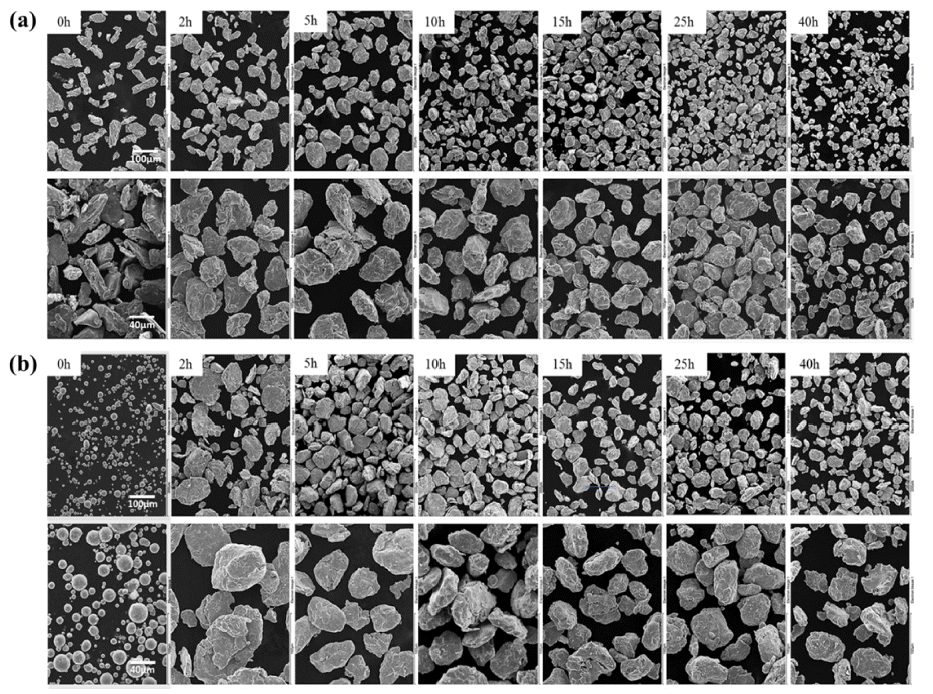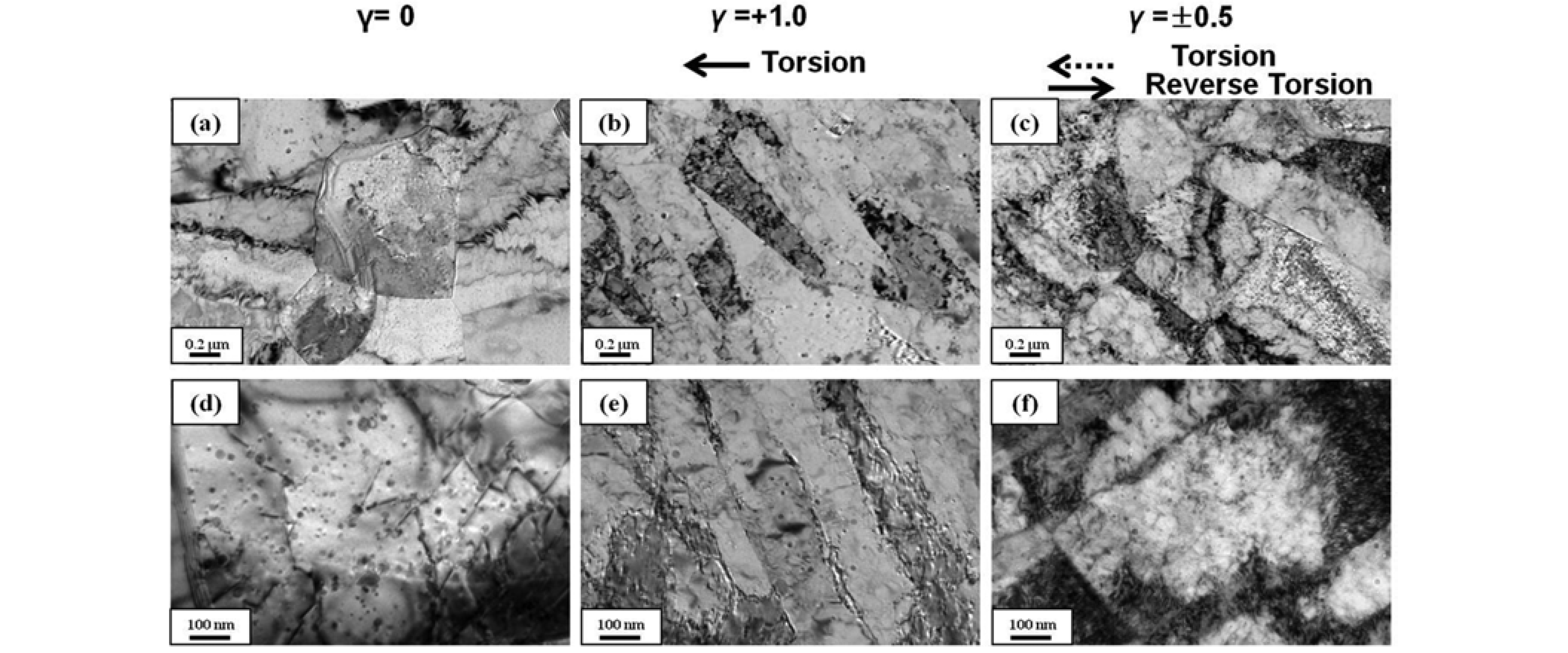Search
- Page Path
- HOME > Search
- [Korean]
- Evolution on Microstructures and Tensile Properties of 10Cr-1Mo ODS Steel with Different Lengths of Mechanical Alloying Process Times
- Sanghoon Noh, Tae Kyu Kim
- J Korean Powder Metall Inst. 2021;28(5):375-380. Published online October 1, 2021
- DOI: https://doi.org/10.4150/KPMI.2021.28.5.375

- 729 View
- 6 Download
-
 Abstract
Abstract
 PDF
PDF In this study, we investigate the effect of the duration of mechanical alloying on the microstructures and mechanical properties of ODS ferritic/martensitic steel. The Fe(bal.)-10Cr-1Mo pre-alloyed powder and Y2O3 powder are mechanically alloyed for the different mechanical alloying duration (0 to 40 h) and then constantly fabricated using a uniaxial hot pressing process. Upon increasing the mechanical alloying time, the average powder diameter and crystallite size increased dramatically. In the initial stages within 5 h of mechanical alloying, inhomogeneous grain morphology is observed along with coarsened carbide and oxide distributions; thus, precipitate phases are temporarily observed between the two powders because of insufficient collision energy to get fragmented. After 40 h of the MA process, however, fine martensitic grains and uniformly distributed oxide particles are observed. This led to a favorable tensile strength and elongation at room temperature and 650°C.
- [Korean]
- A Precipitation Behavior of Nano-Oxide Particles in Mechanically Alloyed Fe-5Y2O3 Powders
- Ga Eon Kim, Sanghoon Noh, Ji Eun Choi, Young Do Kim, Tae Kyu Kim
- J Korean Powder Metall Inst. 2015;22(1):46-51. Published online February 1, 2015
- DOI: https://doi.org/10.4150/KPMI.2015.22.1.46

- 732 View
- 2 Download
- 1 Citations
-
 Abstract
Abstract
 PDF
PDF A precipitation behavior of nano-oxide particle in Fe-5Y2O3 alloy powders is studied. The mechanically alloyed Fe-5Y2O3 powders are pressed at 750°C for 1h, 850°C for 1h and 1150°C for 1h, respectively. The results of Xray diffraction pattern analysis indicate that the Y2O3 diffraction peak disappear after mechanically alloying process, but Y2O3 and YFe2O4 complex oxide precipitates peak are observed in the powders pressed at 1150°C. The differential scanning calorimetry study results reveal that the formation of precipitates occur at around 1054°C. Based on the transmission electron microscopy analysis result, the oxide particles with a composition of Y-Fe-O are found in the Fe-5Y2O3 alloy powders pressed at 1150°C. It is thus conclude that the mechanically alloyed Fe-5Y2O3 powders have no precipitates and the oxide particles in the powders are formed by a high temperature heat-treatment.
-
Citations
Citations to this article as recorded by- Mechanical properties of Mo-Si-B alloys fabricated by using core-shell powder with dispersion of yttria nanoparticles
Jong Min Byun, Su-Ryong Bang, Won June Choi, Min Sang Kim, Goo Won Noh, Young Do Kim
Metals and Materials International.2017; 23(1): 170. CrossRef
- Mechanical properties of Mo-Si-B alloys fabricated by using core-shell powder with dispersion of yttria nanoparticles
- [Korean]
- Microstructure Evolution of 15Cr ODS Steel by a Simple Torsion Test
- Hyun Ju Jin, Suk Hoon Kang, Tae Kyu Kim
- J Korean Powder Metall Inst. 2014;21(4):271-276. Published online August 1, 2014
- DOI: https://doi.org/10.4150/KPMI.2014.21.4.271

- 568 View
- 1 Download
- 4 Citations
-
 Abstract
Abstract
 PDF
PDF 15Cr-1Mo base oxide dispersion strengthened (ODS) steel which is considered to be as a promising candidate for high- temperature components in nuclear fusion and fission systems because of its excellent high temperature strength, corrosion and radiation resistance was fabricated by using mechanical alloying, hot isostatic pressing and hot rolling. Torsion tests were performed at room temperature, leading to two different shear strain routes in the forward and reverse directions. In this study, microstructure evolution of the ODS steel during simple shearing was investigated. Fine grained microstructure and a cell structure of dislocation with low angle boundaries were characterized with shear strain in the shear deformed region by electron backscattered diffraction (EBSD). Grain refinement with shear strain resulted in an increase in hardness. After the forward-reverse torsion, the hardness value was measured to be higher than that of the forward torsion only with an identical shear strain amount, suggesting that new dislocation cell structures inside the grain were generated, thus resulting in a larger strengthening of the steel.
-
Citations
Citations to this article as recorded by- Effect of high-energy ball milling on the microstructure and mechanical properties of Ni-based ODS alloys fabricated using gas-atomized powder
Chun Woong Park, Won June Choi, Jongmin Byun, Young Do Kim
Journal of Materials Science.2022; 57(38): 18195. CrossRef - Analysis on Milling Behavior of Oxide Dispersion Strengthened Ni-based Atomizing Powder with Ni5Y Intermetallic Phase
Chun Woong Park, Jong Min Byun, Won June Choi, Young Do Kim
Journal of Korean Powder Metallurgy Institute.2019; 26(2): 101. CrossRef - Current Status and Future Prospective of Advanced Radiation Resistant Oxide Dispersion Strengthened Steel (ARROS) Development for Nuclear Reactor System Applications
Tae Kyu Kim, Sanghoon Noh, Suk Hoon Kang, Jin Ju Park, Hyun Ju Jin, Min Ku Lee, Jinsugn Jang, Chang Kyu Rhee
Nuclear Engineering and Technology.2016; 48(2): 572. CrossRef - A Precipitation Behavior of Nano-Oxide Particles in Mechanically Alloyed Fe-5Y2O3Powders
Ga Eon Kim, Sanghoon Noh, Ji Eun Choi, Young Do Kim, Tae Kyu Kim
Journal of Korean Powder Metallurgy Institute.2015; 22(1): 46. CrossRef
- Effect of high-energy ball milling on the microstructure and mechanical properties of Ni-based ODS alloys fabricated using gas-atomized powder
TOP
 KPMI
KPMI


 First
First Prev
Prev


